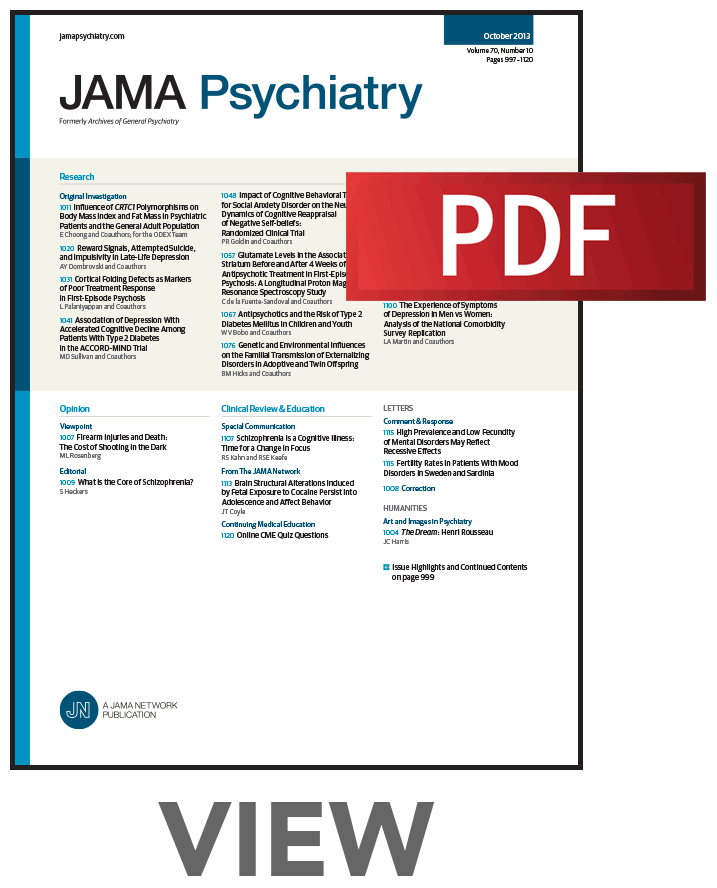精神障碍遗传风险概况。
IF 17.1
1区 医学
Q1 PSYCHIATRY
引用次数: 0
摘要
4种罕见/有争议的精神障碍(妄想障碍[DD]、急性精神病[AP]、未指明精神病[PNOS]和分裂情感性障碍[SAD])的病因学相互关系尚不清楚。目的评估DD、AP、PNOS和SAD患者精神分裂症(SZ)、双相情感障碍(BD)和重度抑郁症(MD)的家族遗传风险评分(FGRS)水平,从而阐明它们之间的遗传关系。设计、环境和参与者本队列研究包括1950年至2000年间出生在瑞典的所有个体,其父母为瑞典人,随访至2018年,根据国家登记处的诊断代码,诊断为MD、BD、SZ、SAD、AP、PNOS和DD。SZ、BD和MD的暴露fgrs从一级到第五度亲属计算,控制同居。DD、AP、PNOS和SAD的诊断。ResultsIn队列667 012个人MD(420 142女性(63%)和246 870男性[37.0%]),58 385 BD(36 344女性(62%)和22 男丁041[38%]),17 465年深圳(6330女性(36%)和11 男丁135[64%]),7597年悲伤(4125女性(54%)和3472年男性[46%]),16 315年美联社(7907女性(49%)和8408年男性[51%]),27 127 PNOS(12 277女性(45%)和14 男丁850[55%]),和11 560 DD(5060女性(44%)和6500年男性[56%])。在SZ FGRS、BD FGRS和MD FGRS的“遗传图谱”上,与SZ病例和相似水平的BD和MD风险相比,DD单独存在大约一半的SZ遗传风险。悲伤也是截然不同的,唯一的障碍相当高遗传风险深圳和BD显然是分离于精神病BD。美联社和PNOS有类似的基因档案与水平的深圳FGRS类似于DD但更高水平的遗传风险BD和MD。细分精神病的结果产生最小影响DD基因档案,对美联社和PNOS适度的影响,对悲伤和大影响,具有良好的社会效益与深圳FGRS降低,增加BD FGRS有关。结论和相关性在瑞典人群中,从遗传学角度来看,这4种疾病中没有一种是SZ、BD或MD的亚型。对DD、AP、PNOS和SAD综合征的进一步遗传学研究有助于了解遗传风险维度与精神疾病的临床表现和病程之间的关系。本文章由计算机程序翻译,如有差异,请以英文原文为准。
Profiles of Genetic Risks for Psychotic Disorders.
Importance
The etiologic interrelationship of 4 rare/controversial psychotic disorders (delusional disorder [DD], acute psychoses [AP], psychosis not otherwise specified [PNOS], and schizoaffective disorder [SAD]) is poorly understood.
Objective
To assess levels of the family genetic risk score (FGRS) for schizophrenia (SZ), bipolar disorder (BD), and major depression (MD) in individuals with DD, AP, PNOS, and SAD, thereby clarifying their genetic relationships.
Design, Setting, and Participants
This cohort study included all individuals born in Sweden between 1950 and 2000 to Swedish-born parents followed up until 2018 with diagnoses of MD, BD, SZ, SAD, AP, PNOS, and DD, based on diagnosis codes from national registries.
Exposures
FGRS for SZ, BD, and MD calculated from first- through fifth-degree relatives, controlling for cohabitation.
Main Outcomes and Measures
Diagnoses of DD, AP, PNOS, and SAD.
Results
In the cohort, 667 012 individuals had MD (420 142 females [63%] and 246 870 males [37.0%]), 58 385 had BD (36 344 females [62%] and 22 041 males [38%]), 17 465 had SZ (6330 females [36%] and 11 135 males [64%]), 7597 had SAD (4125 females [54%] and 3472 males [46%]), 16 315 had AP (7907 females [49%] and 8408 males [51%]), 27 127 had PNOS (12 277 females [45%] and 14 850 males [55%]), and 11 560 had DD (5060 females [44%] and 6500 males [56%]). On "genetic maps" of SZ FGRS, BD FGRS, and MD FGRS, DD stood alone with approximately half the genetic risk for SZ compared with SZ cases and similar levels of BD and MD risk. SAD was also distinct as the only disorder with quite high genetic risks for both SZ and BD and was clearly separable from psychotic BD. AP and PNOS had similar genetic profiles with levels of SZ FGRS similar to DD but higher levels of genetic risk for BD and MD. Subdividing psychoses by outcome produced minimal effects on the DD genetic profile, moderate effects on AP and PNOS, and large effects on SAD, with good social outcomes associated with decreased SZ FGRS and increased BD FGRS.
Conclusions and Relevance
In a Swedish population, none of the 4 disorders appeared, from a genetic perspective, to be subtypes of SZ, BD, or MD. Further genetics research on the syndromes of DD, AP, PNOS, and SAD have much to teach about the relationship between dimensions of genetic risks and the clinical presentation and course of psychotic illness.
求助全文
通过发布文献求助,成功后即可免费获取论文全文。
去求助
来源期刊

JAMA Psychiatry
PSYCHIATRY-
CiteScore
30.60
自引率
1.90%
发文量
233
期刊介绍:
JAMA Psychiatry is a global, peer-reviewed journal catering to clinicians, scholars, and research scientists in psychiatry, mental health, behavioral science, and related fields. The Archives of Neurology & Psychiatry originated in 1919, splitting into two journals in 1959: Archives of Neurology and Archives of General Psychiatry. In 2013, these evolved into JAMA Neurology and JAMA Psychiatry, respectively. JAMA Psychiatry is affiliated with the JAMA Network, a group of peer-reviewed medical and specialty publications.
 求助内容:
求助内容: 应助结果提醒方式:
应助结果提醒方式:


